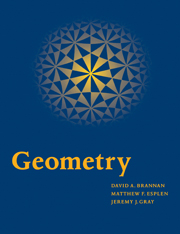Book contents
- Frontmatter
- Contents
- preface
- Introduction: Geometry and Geometries
- 1 Conics
- 2 Affine Geometry
- 3 Projective Geometry: Lines
- 4 Projective Geometry: conics
- 5 Inversive Geometry
- 6 Non-Euclidean Geometry
- 7 Spherical Geometry
- 8 The Kleinian View of Geometry
- Appendix 1 A Primer of Group Theory
- Appendix 2 A Primer of Vectors and Vector Spaces
- Appendix 3 Solutions to the Problems
- Index
preface
Published online by Cambridge University Press: 05 June 2012
- Frontmatter
- Contents
- preface
- Introduction: Geometry and Geometries
- 1 Conics
- 2 Affine Geometry
- 3 Projective Geometry: Lines
- 4 Projective Geometry: conics
- 5 Inversive Geometry
- 6 Non-Euclidean Geometry
- 7 Spherical Geometry
- 8 The Kleinian View of Geometry
- Appendix 1 A Primer of Group Theory
- Appendix 2 A Primer of Vectors and Vector Spaces
- Appendix 3 Solutions to the Problems
- Index
Summary
Geometry! For over two thousand years it was one of the criteria for recognition as an educated person to be acquainted with the subject of geometry. Euclidean geometry, of course.
Plato (c. 427–347 BC) was an Athenian philosopher who established a school of theoretical research (with a mathematical bias), legislation and government
In the golden era of Greek civilization around 400 BC, geometry was studied rigorously and put on a firm theoretical basis – for intellectual satisfaction, the intrinsic beauty of many geometrical results, and the utility of the subject. For example, it was written above the door of Plato's Academy ‘Let no-one ignorant of Geometry enter here!’ Indeed, Archimedes is said to have used the reflection properties of a parabola to focus sunlight on the sails of the Roman fleet besieging Syracuse and set them on flame.
Archimedes (c. 287–212 BC) was a Greek geometer and physicist who used many of the basic limiting ideas of differential and integral calculus.
For two millennia the children of those families sufficiently well-off to be educated were compelled to have their minds trained in the noble art of rigorous mathematical thinking by the careful study of translations of the work of Euclid. This involved grasping the notions of axioms and postulates, the drawing of suitable construction lines, and the careful deduction of the necessary results from the given facts and the Euclidean axioms – generally in two-dimensional or three-dimensional Euclidean space (which we shall denote by ℝ2 and ℝ3respectively).
- Type
- Chapter
- Information
- Geometry , pp. ix - xiiPublisher: Cambridge University PressPrint publication year: 1999



